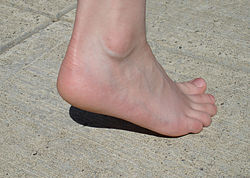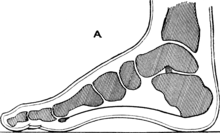Heel
| Heel | |
|---|---|
 A girl heel | |
| Details | |
| Identifiers | |
| Latin | calx |
| MeSH | D006365 |
| TA98 | A01.1.00.042 |
| TA2 | 167 |
| FMA | 24994 |
| Anatomical terminology | |
Theheelis the prominence at the posterior end of thefoot.It is based on the projection of one bone, thecalcaneusor heel bone, behind the articulation of the bones of the lowerleg.
Structure
[edit]

To distribute the compressive forces exerted on the heel duringgait,and especially the stance phase when the heel contacts the ground, thesoleof the foot is covered by a layer of subcutaneous connective tissue up to 2 cm thick (under the heel). This tissue has a system of pressure chambers that both acts as a shock absorber and stabilises the sole. Each of these chambers contains fibrofatty tissue covered by a layer of tough connective tissue made ofcollagenfibers. Thesesepta( "walls" ) are firmly attached both to theplantar aponeurosisabove and the sole'sskinbelow. The sole of the foot is one of the most highly vascularized regions of the body surface, and the dense system of blood vessels further stabilize the septa. [1]
TheAchilles tendonis the muscle tendon of thetriceps surae,a "three-headed" group of muscles—thesoleusand the two heads of thegastrocnemius.The main function of the triceps surae isplantar flexion,i.e. to stretch the foot downward. It is accompanied by a "fourth head", the slightplantaris muscle,the long slender tendon of which is also attached to the heel bone but not visible. [2]
Function
[edit]The compressive forces applied to the foot are distributed along five rays, three medial (side of big toe) and two lateral (side of little toe). The lateral rays stretch over thecuboid boneto theheel boneand the medial rays over the three cuneiform bones and thenavicular boneto theankle bone.Because the ankle bone is placed over the heel bone, these rays are adjacent near the toes but overriding near the heel, and together they form thearches of the footthat are optimized to distributed compressive forces across an uneven terrain. In this context the heel thus forms the posterior point of support that together with theballsof the large and little toes bear the brunt of the loads.[3]
Cracked heels
[edit]Cracked heels is a common health problem and it may causeinfections.It is caused by dryness of the foot skin,[4]and accumulation ofdead skin.Over time, it may cause pain and irritations. Variousmoisturising creamsandfoot filesare available to cure and prevent it.
Other animals
[edit]In the long-footed mammals, both the hoofed species (unguligrade) and the clawed forms which walk on the toes (digitigrade), the heel is well above the ground at the apex of the angular joint known as thehock.Inplantigradespecies, it rests on the ground. In birds, the heel is the backward-pointing joint which is often mistaken as the "knee"(the actual knee of birds is hidden under the plumage).
See also
[edit]- Achilles' heela metaphor for weakness
- Heel of Italy,the SE (after its position in the 'boot')
- Ball of the foot
- Calcaneal spurheel-bone
- CallusHard skin which may cause painful cracks in the heel andsoleof thefoot
- Plantar fasciitis"policeman's heel" disorder
- High-heeled footwearfashion
- Squatting position
Notes
[edit]- ^Thieme Atlas2006, p 418
- ^Thieme Atlas2006, p 434
- ^Thieme Atlas2006, p 412
- ^"Dry, Cracked Feet: Treatment, Causes, and Home Remedies".www.footvitals.com.Archived fromthe originalon 2021-04-25.Retrieved2016-09-26.
References
[edit]- Thieme Atlas of Anatomy: General Anatomy and Musculoskeletal System.Thieme. 2006.ISBN1-58890-419-9.
